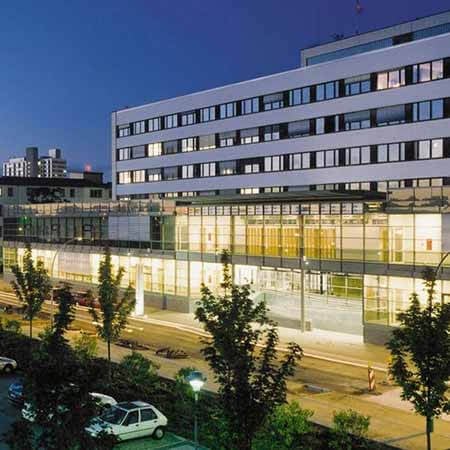About the disease
Facial nerve paresis manifests itself in the asymmetry of facial muscles on one side which results in changing of facial appearance.
The whole appearance of the face changes. The most common cause of paresis is upper respiratory tract infection, but there are several factors that can provoke this disease. Facial nerve paresis can be completely eliminated only if the treatment began on time. Facial nerve paresis is rare disease of nervous system affecting 20 person in hundred thousand. Men and women equally affected by this disease. Facial nerve paresis can appear at any age, but most often it can develop after 40 years old.
There are two main types of facial nerve paresis: peripheral and central one. Most often disease begins with severe pain behind the ear or in parotid region. After that nerve cells become swollen and muscles - deformed. Central paresis is a much less known form of this disease and it affects muscles located in the lower part of the face. It means that the forehead and eyes remain in their normal state. On palpation muscles on the lower part of face feel tense.
Facial nerve endings are responsible for motor and sensory functioning of facial muscles. If there are not enough facial nerve impulses, muscles become weak and can no longer perform their primary function. Facial nerves also regulate taste buds on tongue, sensory fibers of the upper part of the face. Pathological process is usually visible only on one side which results in face deformity.
It can be a consequence of tumors or symptoms of this disease can occur after surgical intervention conducted on the middle ear and the jaw. Paresis of the facial nerve can also be caused by severe case of flu, otitis and herpesvirus, caught in childhood. Most serious complications of facial nerve paresis include hearing loss and, in some cases, decrease of vision. According to American medical site Health Line, this disease can also be caused by stroke. Paresis can develop during the actual seizure of stroke when brain cells get damaged.
Sometimes babies are born with facial nerve paresis. There are several reasons for the pathology in this case. They include cases of birth traumas or infectious illness, that mother had during gestation period.
Facial nerve paresis in newborn baby is manifested by drooping corners of lips and feeding difficulties. In more mild forms of disease it can be fixed with professional massage.
Symptoms
Immobility of facial nerves is the most common symptom of this disease. Facial nerve paresis usually has an acute stage, which can continue up to 2 weeks and passive stage that can last another month. Chronic stage can begin if disease is not treated in first of months. Other symptoms include:
- Drooping of the mouth
- Eyelids become wide open
- Reduced sense of taste
- Decreased tearing or increased dryness of eyes
- Sharp pain behind the ear
During the mild facial nerve paresis asymmetry is not very pronounced: only drooping of the mouth to the affected side is present Paresis of moderate severity is characterized by movement of facial nerves. Severe paresis manifests itself in a pronounced asymmetry. Eye on the affected side is almost closed.
Diagnosis
Clinical signs of paresis are seen from the beginning. Nevertheless, a patient may require medical examination to determine the progression of the disease. Electroneurogram can also measure the celerity of the nerve impulse passing through the peripheral fibers.
Treatment
- Surgical treatment is indicated if there is complete destruction of nerves. Such destruction can be caused by injuries or congenital abnormalities. Effectiveness of the operations is possible only if it is done during the first year of the disease, because later the muscles on the face become completely atrophied and nerve repair will not be possible.
- If a case is mild or moderate, neurorehabilitation can last about six months. During this time a patient has to undergo medical treatment, physiotherapy, massage and course of gymnastics. Treatment depends on the particular case and usually physician decides which course of treatment is necessary. Drugs that are applied in this case relieve swelling and inflammation and are also aimed at the regeneration of nerve cells.
- Pain relief is achieved by injecting special analgesics and muscle relaxants. Sometimes patients with facial nerve paresis feel anxiety and can be prescribed sedatives. Sedatives help to calm down and at the same time partially relieve muscle spasms. If needed, vitamin B can be prescribed to strengthen muscles. Artificial tears can be prescribed to moisture mucosa and prevent secondary infection development. Symptomatic treatment is given on the basis of secondary signs of the disease.
- Physiotherapy includes treatment with sollux, which is a special lamp for light therapy. This lamp can treat nerve endings. Homeopathic remedies can also be a good treatment of facial nerve paresis, but it must be administered carefully, as it can permanently disfigure face. In homeopathy, many drugs are made on the basis of poisonous plants, so their dosage should be observed strictly. Also acupuncture is widely used in treatment of facial nerve paresis.
Authors:
This article was edited by medical experts, board-certified doctors Dr. Nadezhda Ivanisova, and Dr. Bohdan Mykhalniuk. For the treatment of the conditions referred to in the article, you must consult a doctor; the information in the article is not intended for self-medication!
Our editorial policy, which details our commitment to accuracy and transparency, is available here. Click this link to review our policies.














